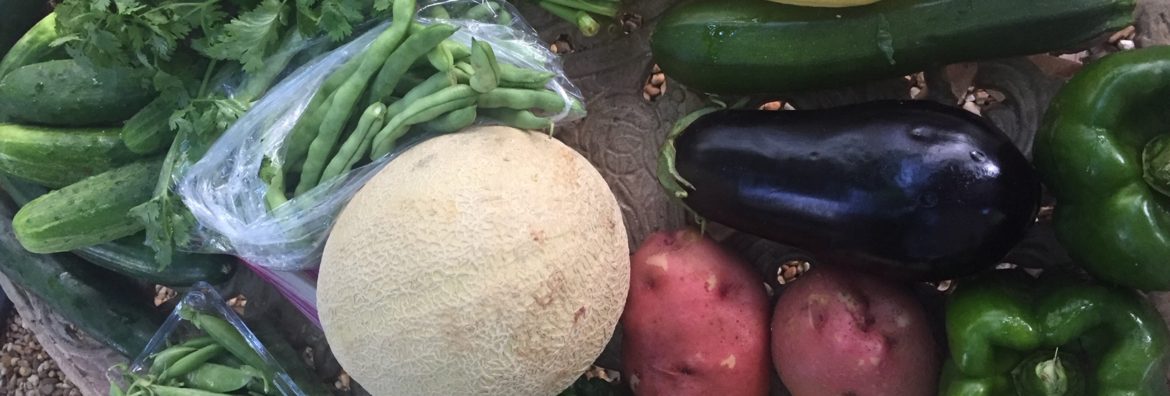What a box today. Wish I knew the variety of that melon, it smells so delicious. Haven’t cut into it yet but can’t wait..
I’ve been waiting for potatoes to appear – yay! – and the first eggplants. Those Chinese (or are they Japanese eggplants) are more tender than their Italian cousins so no need to peel and no need for that salt treatment people sometimes use to reduce bitterness in eggplant. My eggplant is going on the grill tonight – no sojourn in the refrigerator for us. Eggplant is one of those vegetables you should use right away. Left to sit ‘on the counter it can shrivel and left in the refrigerator, it can begin to pit. It’s the first thing I’ll use out of the box.
And I’ll enjoy it while also munching on those sugar snap peas.
I’m grilling mine since I will have the grill going anyway, but if I weren’t grilling, I’d make this Chinese-style Steamed Eggplant. Or this recipe for Sichuan Eggplant from Duluth’s Masterpiece, a recipe we ran in the AJC several weeks ago.
Or what about this Layered Vegetable Torte that uses eggplant, squash and peppers? When tomatoes come back to the box (and if there’s eggplant, too), I’ll be making this Eggplant Caprese Salad.
The bounty of green beans this year sends me to Riverview’s green bean page pretty regularly. Today’s batch will probably end up in a Nicoise Salad, one of my favorite summer salads.
If you read through my ramblings regularly, you know I am a pickle fan. Aluma Farms sent out the recipe for easy pickles in their e-blast the other day, saying “This is for the pickle-fiends!” by which they mean me! I am going through a pint of my quick sweet pickled Kirby cucumbers pretty much every day (a recipe I shared a few weeks ago).
Today’s haul will get pickled as well, and I’m going to add a few of the smaller squash. Really, I could make those pickles a meal. Love that the Aluma Farm recipe helps you understand how much brine to make, depending on how many pickles you’re putting up. Really helpful for those of us pickling on the fly.
Aluma Farm’s Veggie Pickles
Slice your veggies into spears (for carrots that might be in half or quarters, for cucumbers, that might be sixths) and fill as many canning jars as you need. You might need to trim the vegetables to a shorter length to fit.
Take the total volume of jars you filled with veggies and divide it in two to figure out how much brine you need to make.
For instance, if you have four 16-ounce (quart) jars, you have 64 ounces total volume and would need 32 ounces of pickling brine. Combine equal parts water and vinegar to make your brine (if you need 32 ounces total, you would use 16 ounces (2 cups) vinegar and 16 ounces (2 cups) water.)
Heat up the brine, adding several teaspoons regular salt, celery salt to taste, some sugar, some coriander seeds, and as many cloves of garlic as you want (this will all vary by how much total brine you are making.)
A good rule of thumb is 2 teaspoons salt and 1 teaspoon sugar per 8 ounces (1 cup) of pickling liquid, but taste as you add to adjust for your preferences. You can also add any of the following spices: black peppercorns, mustard seeds, fennel seeds, cumin seeds – almost any seeds work!
Bring your brine to a boil, cool for a few minutes, and pour slowly into your jars of sliced veggies! Be careful – sometimes the brine can take a while to percolate down to the bottom of the jar and overflow if you pour too quickly. Put the lids on the jars and stick ’em in the fridge, or can them, following USDA approved canning instructions. Ta-da! You now have homemade pickles!

